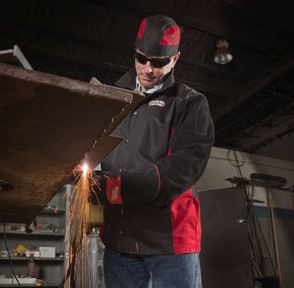 When does it make sense to use a plasma cutter?
When does it make sense to use a plasma cutter?
December 1, 2014 REDWIRE is news you can use from leading suppliers. Powered by FRASERS.
Posted by Lincoln Electric (Canada)
World Leader in the Design & Manufacture Of Arc Welding Equipment & Consumables, Robotic/Automation Welding Solu... Read more
Subscribe
Free REDWIRE e-newsletter

Do you need a cutting tool for occasional repair and maintenance work? Have you recently embarked on a new project that requires higher cutting volumes? Are you looking for an alternative to your current mechanical saw? All of these scenarios provide great reasons to investigate plasma cutting.
Lincoln Electric, a company that designs and manufactures arc welding equipment and consumables, plasma cutters and more, has compiled a list of questions and answers designed to help you determine whether a plasma cutter is right for you.
What is plasma cutting technology?
In simple terms, plasma cutting is a process that uses a high velocity jet of ionized gas that is delivered from a constricting orifice. The high velocity ionized gas — the plasma — conducts electricity from the torch of the plasma cutter to the workpiece. The plasma heats the workpiece, melting the material. The high velocity stream of ionized gas mechanically blows the molten metal away, severing the material.
How does plasma cutting compare to oxyfuel cutting?
Plasma cutting can be performed on any type of conductive metal — mild steel, aluminum and stainless are some examples. With mild steel, operators will experience faster, thicker cuts than with alloys.
Oxyfuel cuts by burning, or oxidizing, the metal it is severing. It is therefore limited to steel and other ferrous metals that support the oxidizing process. Metals like aluminum and stainless steel form an oxide that inhibits further oxidization, making conventional oxyfuel cutting impossible. Plasma cutting, however, does not rely on oxidation to work, and thus it can cut aluminum, stainless and any other conductive material.
While different gasses can be used for plasma cutting, most people today use compressed air for the plasma gas. In most shops, compressed air is readily available, and thus plasma does not require fuel gas and compressed oxygen for operation.
Plasma cutting is typically easier for the novice to master, and on thinner materials, plasma cutting is much faster than oxyfuel cutting. However, for heavy sections of steel (one inch and greater), oxyfuel is still preferred since it is typically faster and, for heavier plate applications, very high capacity power supplies are required for plasma cutting applications.
What can I use a plasma cutter for?
Plasma cutting is ideal for cutting steel and non-ferrous material less than one-inch thick. Oxyfuel cutting requires that the operator carefully control the cutting speed to maintain the oxidizing process. Plasma is more forgiving in this regard. Plasma cutting really shines in some niche applications, such as cutting expanded metal, something that is nearly impossible with oxyfuel. And, compared to mechanical means of cutting, plasma cutting is typically much faster, and can easily make non-linear cuts.
What are the limitations of plasma cutting?
The plasma cutting machines are typically more expensive than oxyacetylene, and also, oxyacetylene does not require access to electrical power or compressed air, which may make it a more convenient method for some users. Oxyfuel can cut thicker sections (greater than one inch) of steel more quickly than plasma.
For more information, contact Lincoln Electric.
Share
Posted by Lincoln Electric (Canada)
World Leader in the Design & Manufacture Of Arc Welding Equipment & Consumables, Robotic/Automation Welding Solu... Read more